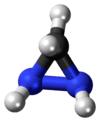Diaziridine
Diaziridines are heterocyclic compounds containing two nitrogen atoms in a three-membered ring. They can be considered as strained hydrazines. Due to the ring strain, the nitrogen atoms are configuration stable leading to cis-trans isomers. They are usually synthesized by a method developed by E. Schmitz: A carbonyl compound is treated with ammonia or respectively a primary aliphatic amine and an aminating reagent like hydroxylamine-O-sulfonic acid (HOSA) under slightly basic conditions.[1] The final step is based on the intramolecular cyclization of an aminal.
| |||
| Names | |||
|---|---|---|---|
| Preferred IUPAC name
Diaziridine | |||
| Systematic IUPAC name
Diazacyclopropane | |||
| Other names
Diazirane 1,2-Diazacyclopropane | |||
| Identifiers | |||
3D model (JSmol) |
|||
| ChemSpider | |||
PubChem CID |
|||
| |||
| |||
| Properties | |||
| CH4N2 | |||
| Molar mass | 44.057 g·mol−1 | ||
Except where otherwise noted, data are given for materials in their standard state (at 25 °C [77 °F], 100 kPa). | |||
| Infobox references | |||
Reactions
- Unsubstituted diaziridines are often directly oxidized (I2/NEt3) to the more stable diazirines.
- They can undergo ring expansion reaction with electrophilic reagents like ketenes or isocyanates.
- Some derivatives are neurotropically active.[2]
gollark: Er. Why.
gollark: Isn't inter-VM networking... not massively hard?
gollark: Also, screenshots.
gollark: But it's kind of bad.
gollark: I mean, if you want the code *now* for some reason, I'll give you it?
References
This article is issued from Wikipedia. The text is licensed under Creative Commons - Attribution - Sharealike. Additional terms may apply for the media files.

